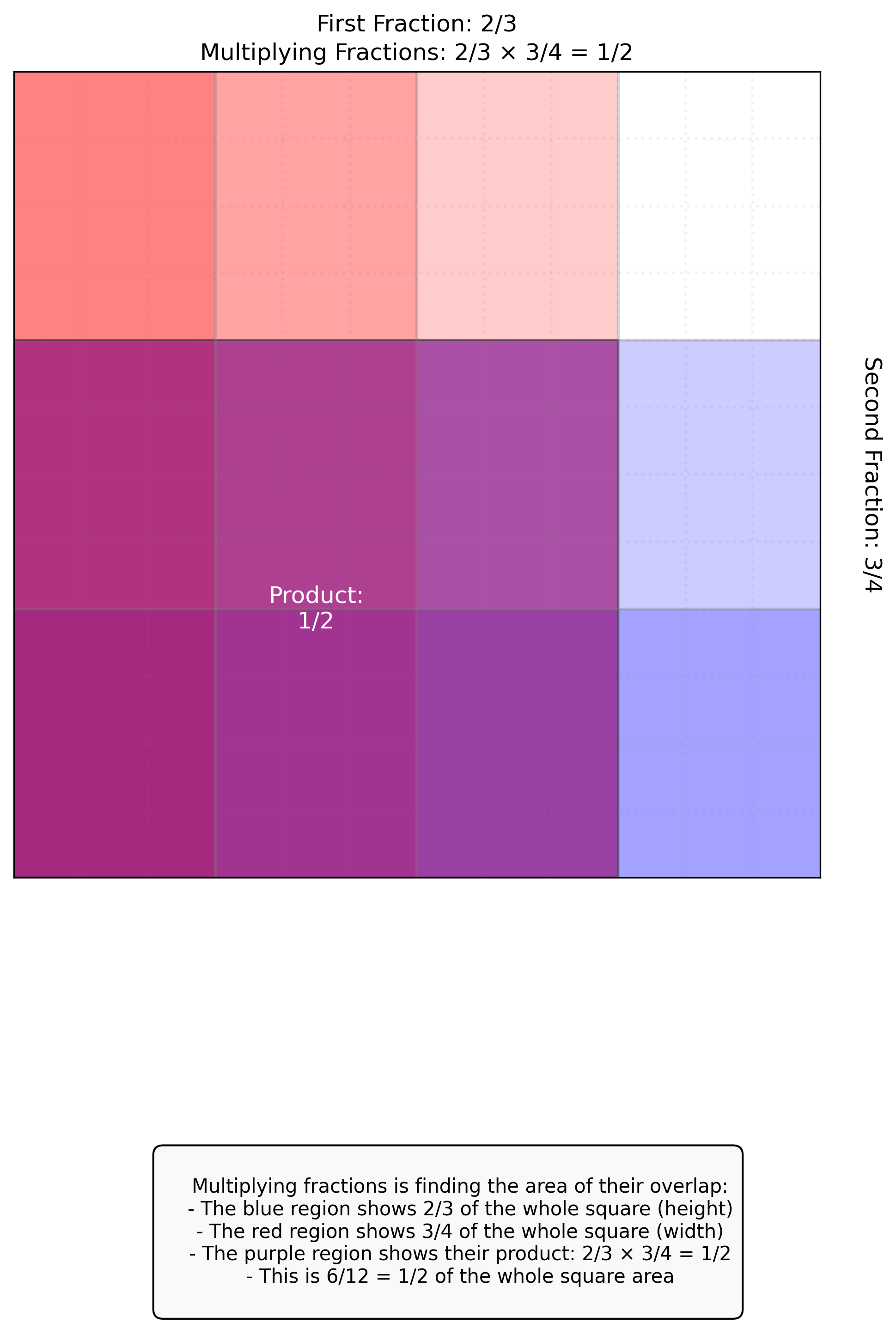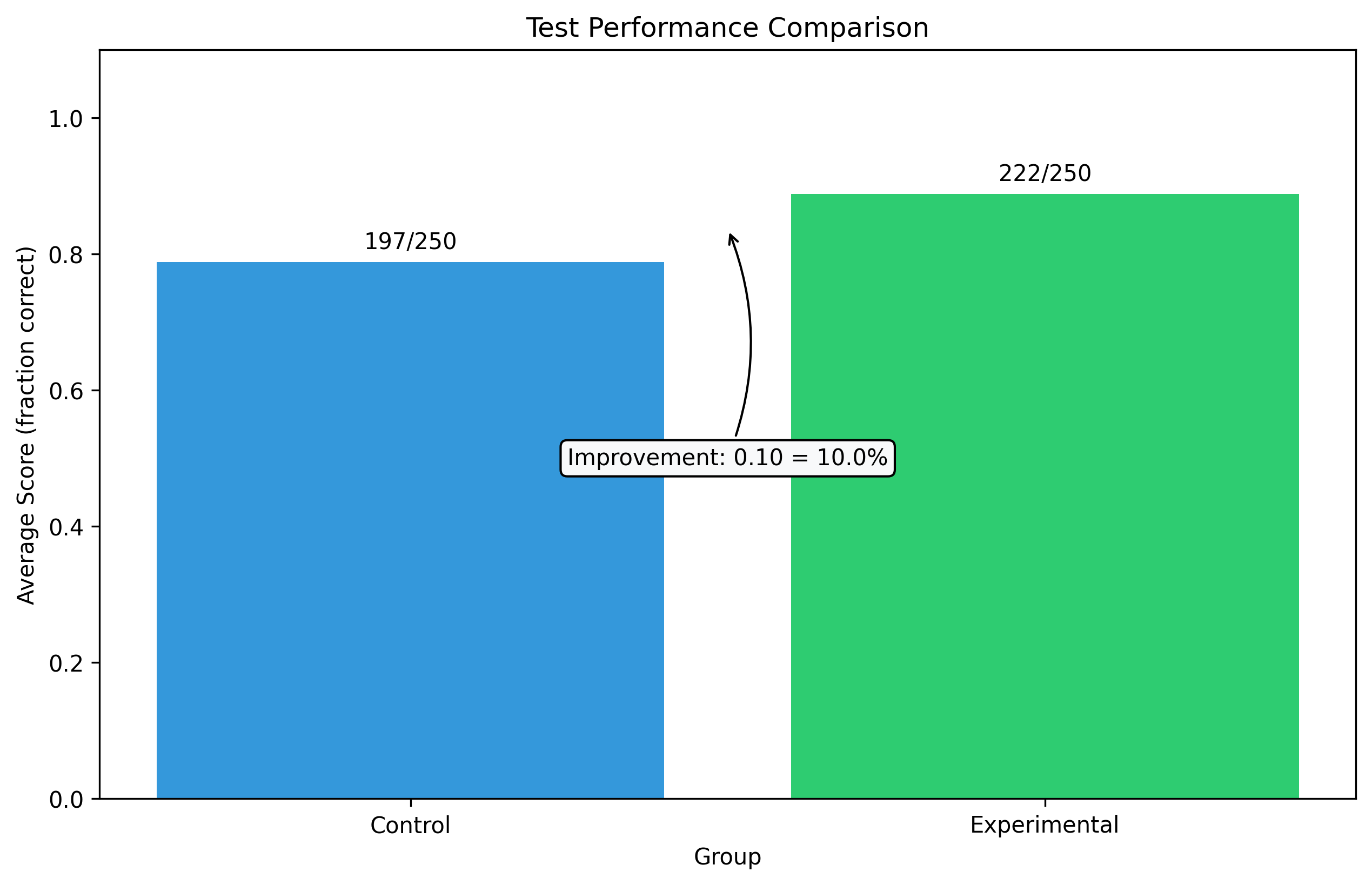Chapter 3.2: Operations with Fractions#
Mathematics for Psychologists and Computation
Welcome to Chapter 3.2! Now that we understand what fractions are, let’s learn how to perform various mathematical operations with them. These operations are fundamental for analyzing data in psychological research.
import matplotlib.pyplot as plt
import numpy as np
from fractions import Fraction
import warnings
warnings.filterwarnings("ignore")
plt.rcParams['axes.grid'] = False # Ensure grid is turned off
plt.rcParams['figure.dpi'] = 300
Adding and Subtracting Fractions#
To add or subtract fractions, we need to have a common denominator (the same number on the bottom).
Steps for adding/subtracting fractions:#
Find a common denominator
Convert each fraction to an equivalent fraction with that common denominator
Add or subtract the numerators
Keep the common denominator
Simplify the result if possible
Example: \(\frac{1}{4} + \frac{2}{3}\)
The least common multiple (LCM) of 4 and 3 is 12
Convert \(\frac{1}{4}\) to \(\frac{3}{12}\) (multiply by \(\frac{3}{3}\))
Convert \(\frac{2}{3}\) to \(\frac{8}{12}\) (multiply by \(\frac{4}{4}\))
Add numerators: \(\frac{3}{12} + \frac{8}{12} = \frac{11}{12}\)
Result: \(\frac{11}{12}\) (already in simplified form)
# Create a simple visualization for fraction addition
def visualize_fraction_addition(frac1_num, frac1_den, frac2_num, frac2_den):
# Calculate result using Python's Fraction class
f1 = Fraction(frac1_num, frac1_den)
f2 = Fraction(frac2_num, frac2_den)
result = f1 + f2
# Find common denominator
def lcm(a, b):
return abs(a * b) // np.gcd(a, b)
common_den = lcm(frac1_den, frac2_den)
# Convert fractions
f1_new_num = frac1_num * (common_den // frac1_den)
f2_new_num = frac2_num * (common_den // frac2_den)
# Create visualization
fig, ax = plt.subplots(figsize=(10, 6))
# Set up number line
ax.set_xlim(0, 2) # Adjust as needed
ax.set_ylim(0, 1)
ax.axhline(y=0.5, color='black', linestyle='-')
# Plot fraction points and arrows
ax.plot(f1.numerator/f1.denominator, 0.5, 'o', markersize=10, color='blue')
ax.text(f1.numerator/f1.denominator, 0.6, f"{frac1_num}/{frac1_den}", ha='center')
# Add arrow for second fraction
ax.arrow(f1.numerator/f1.denominator, 0.5, f2.numerator/f2.denominator, 0,
head_width=0.05, head_length=0.05, fc='green', ec='green')
# Plot result point
ax.plot(result.numerator/result.denominator, 0.5, 'o', markersize=10, color='red')
ax.text(result.numerator/result.denominator, 0.6, f"{result.numerator}/{result.denominator}", ha='center')
# Add annotation with explanation
explanation = f"""
Adding {frac1_num}/{frac1_den} + {frac2_num}/{frac2_den}:
1. Find common denominator: {common_den}
2. Convert to {f1_new_num}/{common_den} + {f2_new_num}/{common_den}
3. Add numerators: {f1_new_num + f2_new_num}/{common_den}
4. Simplify if needed: {result.numerator}/{result.denominator}
"""
# Place explanation in a box
ax.text(0.5, 0.2, explanation, ha='left', va='center',
bbox=dict(boxstyle="round,pad=0.5", fc="#f8f9fa", ec="black", lw=1), fontsize=10)
ax.set_title(f"Adding Fractions: {frac1_num}/{frac1_den} + {frac2_num}/{frac2_den} = {result.numerator}/{result.denominator}")
ax.set_yticks([])
plt.tight_layout()
plt.show()
# Example: Visualize 1/4 + 2/3
visualize_fraction_addition(1, 4, 2, 3)

Let’s implement simple functions to add and subtract fractions:
def add_fractions(num1, den1, num2, den2):
# Find the least common multiple (LCM) for the common denominator
def lcm(a, b):
return abs(a * b) // np.gcd(a, b)
common_den = lcm(den1, den2)
# Convert to equivalent fractions with common denominator
num1_converted = num1 * (common_den // den1)
num2_converted = num2 * (common_den // den2)
# Add the numerators
result_num = num1_converted + num2_converted
# Simplify the result
gcd = np.gcd(result_num, common_den)
result_num = result_num // gcd
result_den = common_den // gcd
return result_num, result_den
def subtract_fractions(num1, den1, num2, den2):
# Similar process to addition, but subtract numerators
def lcm(a, b):
return abs(a * b) // np.gcd(a, b)
common_den = lcm(den1, den2)
num1_converted = num1 * (common_den // den1)
num2_converted = num2 * (common_den // den2)
result_num = num1_converted - num2_converted
# Simplify
gcd = np.gcd(abs(result_num), common_den)
result_num = result_num // gcd
result_den = common_den // gcd
return result_num, result_den
# Examples
print("Addition examples:")
examples_add = [(1, 4, 3, 8), (2, 3, 3, 5), (5, 6, 1, 4)]
for ex in examples_add:
num, den = add_fractions(ex[0], ex[1], ex[2], ex[3])
print(f"{ex[0]}/{ex[1]} + {ex[2]}/{ex[3]} = {num}/{den}")
print("\nSubtraction examples:")
examples_sub = [(5, 6, 1, 3), (7, 8, 1, 4), (2, 3, 1, 6)]
for ex in examples_sub:
num, den = subtract_fractions(ex[0], ex[1], ex[2], ex[3])
print(f"{ex[0]}/{ex[1]} - {ex[2]}/{ex[3]} = {num}/{den}")
Addition examples:
1/4 + 3/8 = 5/8
2/3 + 3/5 = 19/15
5/6 + 1/4 = 13/12
Subtraction examples:
5/6 - 1/3 = 1/2
7/8 - 1/4 = 5/8
2/3 - 1/6 = 1/2
Multiplying Fractions#
Multiplying fractions is actually simpler than adding or subtracting them. We don’t need to find a common denominator!
To multiply fractions:
Multiply the numerators
Multiply the denominators
Simplify if possible
Formula: \(\frac{a}{b} \times \frac{c}{d} = \frac{a \times c}{b \times d}\)
Example: \(\frac{2}{3} \times \frac{5}{7}\)
Multiply numerators: \(2 \times 5 = 10\)
Multiply denominators: \(3 \times 7 = 21\)
Result: \(\frac{10}{21}\) (already in simplest form)
def multiply_fractions(num1, den1, num2, den2):
# Multiply numerators and denominators
result_num = num1 * num2
result_den = den1 * den2
# Simplify if possible
gcd = np.gcd(result_num, result_den)
result_num = result_num // gcd
result_den = result_den // gcd
return result_num, result_den
# Examples
examples_mult = [(2, 3, 5, 7), (1, 4, 2, 3), (3, 5, 10, 11)]
for ex in examples_mult:
num, den = multiply_fractions(ex[0], ex[1], ex[2], ex[3])
print(f"{ex[0]}/{ex[1]} × {ex[2]}/{ex[3]} = {num}/{den}")
2/3 × 5/7 = 10/21
1/4 × 2/3 = 1/6
3/5 × 10/11 = 6/11
Let’s visualize fraction multiplication using an area model, which is helpful for understanding this operation conceptually:
def visualize_fraction_multiplication(num1, den1, num2, den2):
# Calculate product
product_num, product_den = multiply_fractions(num1, den1, num2, den2)
# Create figure
fig, ax = plt.subplots(figsize=(8, 8))
ax.set_xlim(0, 1)
ax.set_ylim(0, 1)
ax.set_aspect('equal')
# Create grid
for i in range(1, den1):
ax.axhline(y=i/den1, color='gray', linestyle='-', alpha=0.3)
for i in range(1, den2):
ax.axvline(x=i/den2, color='gray', linestyle='-', alpha=0.3)
# Highlight the area representing the first fraction
for i in range(num1):
rect = plt.Rectangle((0, 0), 1, (i+1)/den1,
facecolor='blue', alpha=0.2, edgecolor='none')
ax.add_patch(rect)
# Highlight the area representing the second fraction
for i in range(num2):
rect = plt.Rectangle((0, 0), (i+1)/den2, 1,
facecolor='red', alpha=0.2, edgecolor='none')
ax.add_patch(rect)
# Highlight the overlapping area (the product)
rect = plt.Rectangle((0, 0), num2/den2, num1/den1,
facecolor='purple', alpha=0.5, edgecolor='black')
ax.add_patch(rect)
# Add grid lines for the product denominator (optional)
for i in range(1, den1*den2):
ax.axhline(y=i/(den1*den2), color='gray', linestyle=':', alpha=0.1)
ax.axvline(x=i/(den1*den2), color='gray', linestyle=':', alpha=0.1)
# Add labels
ax.text(0.5, 1.05, f"First Fraction: {num1}/{den1}", ha='center', fontsize=12)
ax.text(1.05, 0.5, f"Second Fraction: {num2}/{den2}", va='center', fontsize=12, rotation=-90)
ax.text(num2/(2*den2), num1/(2*den1), f"Product:\n{product_num}/{product_den}",
ha='center', va='center', fontsize=12, color='white')
# Add explanation
explanation = f"""
Multiplying fractions is finding the area of their overlap:
- The blue region shows {num1}/{den1} of the whole square (height)
- The red region shows {num2}/{den2} of the whole square (width)
- The purple region shows their product: {num1}/{den1} × {num2}/{den2} = {product_num}/{product_den}
- This is {num1*num2}/{den1*den2} = {product_num}/{product_den} of the whole square area
"""
plt.figtext(0.5, -0.05, explanation, ha='center', va='top',
bbox=dict(boxstyle="round,pad=0.5", fc="#f8f9fa", ec="black", lw=1), fontsize=10)
ax.set_title(f"Multiplying Fractions: {num1}/{den1} × {num2}/{den2} = {product_num}/{product_den}")
ax.set_xticks([])
ax.set_yticks([])
plt.tight_layout()
plt.subplots_adjust(bottom=0.2)
plt.show()
# Example: Visualize 2/3 × 3/4
visualize_fraction_multiplication(2, 3, 3, 4)

Dividing Fractions#
To divide fractions, we use a simple trick: multiply by the reciprocal of the second fraction.
Steps:
Take the reciprocal (flip) of the second fraction
Multiply the first fraction by this reciprocal
Simplify if possible
Formula: \(\frac{a}{b} ÷ \frac{c}{d} = \frac{a}{b} \times \frac{d}{c} = \frac{a \times d}{b \times c}\)
Example: \(\frac{3}{4} ÷ \frac{2}{5}\)
Reciprocal of \(\frac{2}{5}\) is \(\frac{5}{2}\)
\(\frac{3}{4} \times \frac{5}{2} = \frac{3 \times 5}{4 \times 2} = \frac{15}{8}\)
Result: \(\frac{15}{8}\) (already in simplest form)
def divide_fractions(num1, den1, num2, den2):
# Multiply by the reciprocal
return multiply_fractions(num1, den1, den2, num2)
# Examples
examples_div = [(3, 4, 2, 5), (5, 6, 1, 3), (7, 8, 3, 4)]
for ex in examples_div:
num, den = divide_fractions(ex[0], ex[1], ex[2], ex[3])
print(f"{ex[0]}/{ex[1]} ÷ {ex[2]}/{ex[3]} = {num}/{den}")
3/4 ÷ 2/5 = 15/8
5/6 ÷ 1/3 = 5/2
7/8 ÷ 3/4 = 7/6
Application in Psychology: Analyzing Test Performance#
Let’s use what we’ve learned to analyze some test performance data from a psychological experiment.
# Sample data: Test scores for different groups
# Format: [correct answers, total questions]
control_group = [
[18, 25], [20, 25], [22, 25], [19, 25], [21, 25],
[17, 25], [23, 25], [20, 25], [19, 25], [18, 25]
]
experimental_group = [
[21, 25], [23, 25], [24, 25], [22, 25], [23, 25],
[20, 25], [24, 25], [22, 25], [21, 25], [22, 25]
]
# Convert scores to fractions and calculate averages
def calculate_average_score(group_data):
total_correct = sum(score[0] for score in group_data)
total_questions = sum(score[1] for score in group_data)
return total_correct, total_questions
control_correct, control_total = calculate_average_score(control_group)
experimental_correct, experimental_total = calculate_average_score(experimental_group)
# Calculate improvement as a fraction
control_ratio = control_correct / control_total
experimental_ratio = experimental_correct / experimental_total
improvement = experimental_ratio - control_ratio
# Display results
print(f"Control group average: {control_correct}/{control_total} = {control_ratio:.2f} or {control_ratio*100:.1f}%")
print(f"Experimental group average: {experimental_correct}/{experimental_total} = {experimental_ratio:.2f} or {experimental_ratio*100:.1f}%")
print(f"Improvement: {improvement:.2f} or {improvement*100:.1f}%")
# Visualize the results
plt.figure(figsize=(10, 6))
groups = ['Control', 'Experimental']
scores = [control_ratio, experimental_ratio]
bars = plt.bar(groups, scores, color=['#3498db', '#2ecc71'])
# Add fractions above the bars
plt.text(0, control_ratio + 0.02, f"{control_correct}/{control_total}", ha='center')
plt.text(1, experimental_ratio + 0.02, f"{experimental_correct}/{experimental_total}", ha='center')
# Format the plot
plt.ylim(0, 1.1)
plt.xlabel('Group')
plt.ylabel('Average Score (fraction correct)')
plt.title('Test Performance Comparison')
# Add annotation explaining the improvement
plt.annotate(f"Improvement: {improvement:.2f} = {improvement*100:.1f}%",
xy=(0.5, (control_ratio + experimental_ratio)/2),
xytext=(0.5, 0.5),
ha='center', va='center',
arrowprops=dict(arrowstyle="->", connectionstyle="arc3,rad=.2"),
bbox=dict(boxstyle="round,pad=0.3", fc="#f8f9fa", ec="black", lw=1))
plt.show()
Control group average: 197/250 = 0.79 or 78.8%
Experimental group average: 222/250 = 0.89 or 88.8%
Improvement: 0.10 or 10.0%

Summary#
In this chapter, we’ve learned how to perform basic operations with fractions:
Addition and Subtraction:
Find a common denominator
Convert fractions to equivalent forms with this denominator
Add/subtract the numerators
Simplify the result
Multiplication:
Multiply the numerators
Multiply the denominators
Simplify the result
Division:
Flip (reciprocate) the second fraction
Multiply by this reciprocal
Simplify the result
These operations are essential for analyzing and interpreting data in psychological research, from calculating proportions and averages to comparing experimental results.
Practice Exercises#
Basic Operations: Calculate the following:
\(\frac{2}{5} + \frac{1}{3}\)
\(\frac{5}{8} - \frac{1}{4}\)
\(\frac{3}{7} \times \frac{2}{9}\)
\(\frac{4}{5} ÷ \frac{2}{3}\)
Psychology Application: In a memory experiment, participants in Group A correctly recalled \(\frac{7}{15}\) of the words, while participants in Group B recalled \(\frac{9}{15}\). What fraction of words did Group B recall better than Group A?
Mixed Operations: Solve the following:
\(\frac{3}{4} + \frac{2}{3} - \frac{1}{6}\)
\(\frac{2}{5} \times \frac{10}{3} ÷ \frac{4}{3}\)
Real-world Application: A psychologist found that \(\frac{3}{8}\) of participants showed symptoms of anxiety, while \(\frac{2}{5}\) showed symptoms of depression. If \(\frac{1}{10}\) of all participants showed symptoms of both conditions, what fraction showed symptoms of either anxiety or depression?
Visualization Challenge: Use the provided visualization functions to create a visual representation of multiplying \(\frac{1}{2}\) by \(\frac{2}{3}\). Explain why the result makes sense visually.
